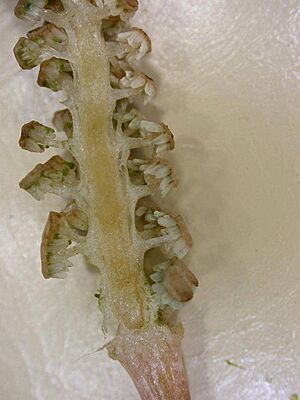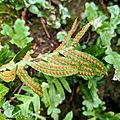Sporangium facts for kids
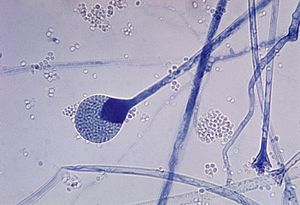
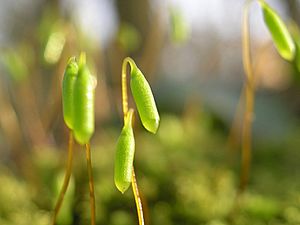
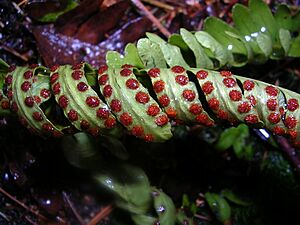
A sporangium (say: spor-AN-jee-um) is like a tiny container where spores are made. Think of spores as tiny seeds that help plants, fungi, and other living things reproduce. A sporangium can be made of just one cell or many cells working together.
Many different organisms have sporangia at some point in their life cycle. This includes all plants, fungi, and even some other simple life forms.
Contents
What is a Sporangium?
A sporangium is a special part of an organism that produces and holds spores. Spores are like tiny reproductive cells. They are very light and can be carried by wind or water to new places. When a spore lands in a good spot, it can grow into a new organism.
Some sporangia make spores using a process called mitosis. This creates spores that are exact copies of the parent cell. This is a type of asexual reproduction. It means the new organism comes from only one parent.
How Sporangia Make Spores
In most land plants and many fungi, sporangia are also where a special process called meiosis happens. Meiosis is different from mitosis. It creates spores that are genetically unique. This means they have a mix of genetic information from two parents. These unique spores are called haploid spores. They have half the usual number of chromosomes. This is part of sexual reproduction, which helps create variety in living things.
Sporangia in Flowering Plants
In flowering plants, the tissue inside the sporangium that makes the female spores is called the nucellus. This nucellus is very important for the plant's reproduction. It helps form the ovule, which later becomes the seed after fertilization.
Where Can You Find Sporangia?
You can find sporangia in many different types of organisms.
- Fungi: Many fungi, like molds, have sporangia. These often look like tiny balls on stalks. They release spores that can grow into new mold colonies.
- Mosses and Ferns: These plants do not have flowers or seeds. Instead, they reproduce using spores. Mosses have sporangia that look like small capsules on top of stalks. Ferns have sporangia grouped together in structures called sori (say: SOH-rye) on the underside of their leaves.
- Other Plants: Even some ancient plants, like horsetails (Equisetum), have sporangia. Their sporangia are found in cone-like structures at the tips of their stems.
Sporangia are a key part of how many different life forms continue their species. They ensure that new generations can grow and thrive in various environments.
Images for kids
-
Scanning electron micrograph of fern leptosporangia
See also
 In Spanish: Esporangio para niños
In Spanish: Esporangio para niños


